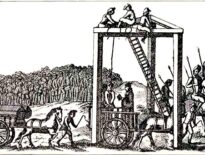This week’s Monday martyr is a courtier whose fall is shrouded in mystery.
Sir Adrian Fortescue was beheaded at Tower Hill on 9th or 10th July 1539.*
Fortescue, who was the second son of Sir John Fortescue and Alice Boleyn, great-aunt of Anne Boleyn, was a loyal royal servant. He was made a Knight of the Bath in Henry VII’s reign. He was present at Henry VII’s funeral and accompanied Henry VIII to the Field of Cloth of Gold and on three of his French campaigns. His first wife was Anne Stonor and the couple settled at Stonor Park in Oxfordshire after she inherited it in 1499.
Fortescue's trouble began when his son-in-law, Thomas Fitzgerald, Silken Thomas, rebelled against the king in 1534. Fortescue was imprisoned but later released, and even raised troops against the Pilgrimage of Grace rebellion. However, he was arrested in February 1539. Chronicler John Stowe explains that Fortescue and Thomas Dingley, a Knight of the Order of St John, with whom Fortescue was executed, were attainted by Parliament in April 1539 "along with Margaret Pole, Countess of Salisbury; Gertrude, wife of the Marquess of Exeter, Reginald Pole, and diverse others".
There is no evidence that Fortescue was a traitor, and his biographer, Richard Rex, points out that there's no evidence that he opposed the king's annulment or supremacy, and that "his missal and book of hours show that he not only dutifully deleted the papal title from the liturgy, but also used bidding prayers describing Henry as supreme head." However, his first wife was related to the Pole family and Cardinal Reginald Pole had been outspoken in his opposition of the king's annulment and supremacy.
In the 17th century, it was believed that Fortescue had been a Knight of the Order of St John and so he became venerated as a martyr of the Catholic Church, and was beatified in 1895.
Notes and Sources
*John Stowe dates Fortescue's execution to 10th July, whereas The Chronicle of the Grey Friars and Charles Wriothesley date it to 9th.
- 'The Chronicle of the Grey Friars: Henry VIII', in Chronicle of the Grey Friars of London Camden Society Old Series: Volume 53, ed. J G Nichols (London, 1852), pp. 29-53. British History Online.
- Wriothesley, Charles. A chronicle of England during the reigns of the Tudors, from A.D. 1485 to 1559, pp. 101-102.
- John Stowe explains that Fortescue and Dingley, along with Margaret Pole, Countess of Salisbury; Gertrude, wife of the Marquess of Exeter, Reginald Pole, and diverse others, were attainted at the Parliament that began on 28th April. Annales, or, a generall chronicle of England, pp. 576-577.



My husband is a direct descendant of Sir Adrian Fortesque. We understand that he was a Knight of the Order of St John and was knighted alongside Prince Henry (later Henry VIII) by Henry VII.